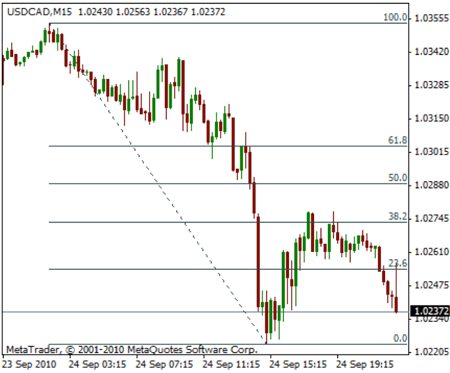Today, I would like to discuss the use of the Fibanacci Retracement technical indicator that many beginning stock traders use to trade stocks, futures ETF’s, etc. The Fibonacci retracement pattern can be useful for swing traders to identify reversals on a stock chart. Looking at stocks for example, once they have moved up or down in a trend, have a great tendency to move back or retrace a certain amount, rather than to move in a completely straight line or direction up or down. Because of this common retracement pattern, stock traders use the Fibonacci Indicators as reference points to predict certain retracements levels as the stock moves back and forth in a trend during a retracement or “pullback”. You will find Fibonacci levels to be very accurate when analyzing chart pattern reversals. Fibonacci indicators also provide an excellent visual map and identify very accurate support and resistance levels. Some Stock trader’s will also combine Fibonacci Retracement levels with common candlestick patterns to identify optimum entry and exit points.
An effective candlestick pattern trading method is to look for small double bottoms or double tops and individual doji or shooting star or hanging man type reversal candle patterns within these Fibonacci levels to identify trading opportunities.
Fibonacci levels are where price retracements or “congestion” often form. Just like moving averages, the Fibonacci levels work like price magnets to old highs or lows and can also form good support and resistance levels. For an even greater degree of accuracy they can be combined with the major candlestick patterns
The most common Fibonacci levels used in technical analysis for drawing Fibonacci lines are 62% (61.8% rounded up), 38%, 24% (23.6 rounded up) and 50%. For existing trends, the 24% level should be the minimum retracement but can go down as low as the 62% level. As price retraces, support and resistance occurs at a high rate near the Fibonacci levels. In an existing rising trend, the retracement lines move down or “retrace” from 100% to 0%. In an existing downtrend, the retracement lines move up or “retrace” from 0% to 100%
You can see in the USDCAD chart above that the retracement retraced to the 38.2% level before continuing the downward trend.
Technical Traders use these Fibonacci Indicators (Fib-lines or Fib-levels) to predict Price Targets and Support/Resistance Targets. To accurately draw the lines to identify these patterns you begin drawing from the lowest point (which equals your 0 percent line) to the highest point (which equals your 100% line). The 38%, 50%, and 62% lines will provide your reference point for targets.
While there is no “crystal ball” and nothing can predict the future with 100% accuracy, but using the Fib-levels can greatly enhance your ability to be in profitable trades. Adding the candlestick signals provide a great advantage for being able to immediately recognize what is going on with investor sentiment at these levels.
Traders Challenge: Over the next few days, add Fibanacci levels to your stock charts and study the retracements, along with common candlestick price patterns to help identify support and resistance areas and potential entries.
